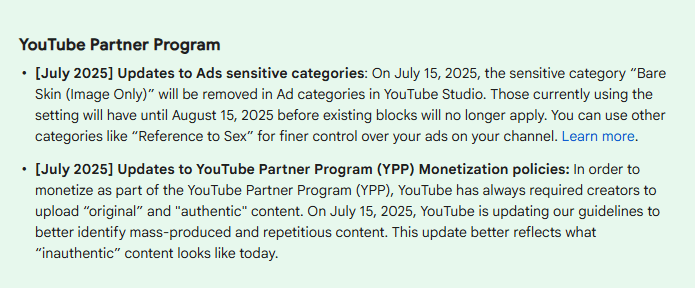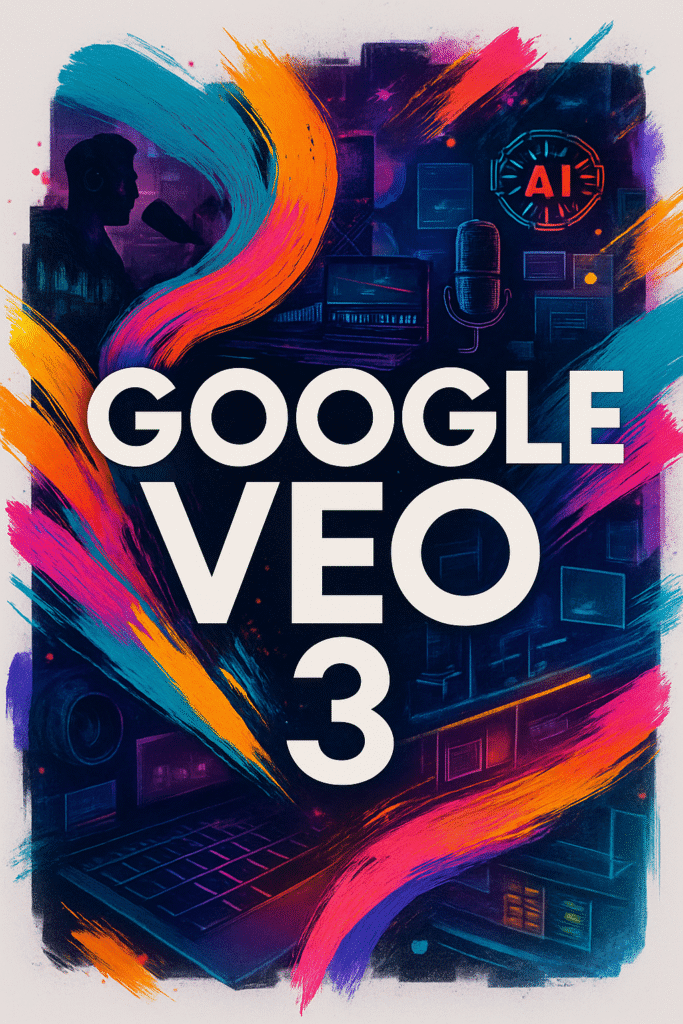The new “Inauthentic Content” policy isn’t a threat to AI-powered creators. It’s an opportunity to leave the low-effort channels behind.

The emails are out. The headlines are everywhere. The creator community is buzzing with a mix of confusion and low-key panic.
YouTube Policy update July 2025, is officially renaming “Repetitious Content” to “Inauthentic Content.”
To many, this sounds like a direct shot at the thousands of channels using AI to create content. It feels like the party might be over. I’ve already seen the questions flooding Reddit and Twitter: “Is my faceless channel doomed?” “Does this mean I can’t use AI voices?” “Is YouTube killing AI creators?”
As the founder of Tubernetic, a company built entirely around helping you leverage AI for YouTube, I want to address this head-on. But first, we need to untangle the confusion. That single announcement email actually contained two completely separate updates. One is minor housekeeping; the other is a monumental shift in the creator landscape.
Let’s break down what it really means and how you can ensure you’re on the right side of it.
The Housekeeping: A Quick Change to Your Ad Settings
This first part is simple and has nothing to do with the content you create. It’s about the ads you allow to run on your videos.
- What’s Changing: The sensitive ad category called “Bare Skin (Image Only)” is being removed from your YouTube Studio ad settings.
- What It’s Becoming: It’s being merged into a smarter, broader category called “Reference to Sex.” This just gives you finer, more accurate control over the types of ads you want to block.
- The Deadline: If you are currently blocking the “Bare Skin” category, that block will stop working on August 15, 2025.
- The Founder’s Verdict: This is a minor, positive change. Action required: If you were blocking “Bare Skin,” take 60 seconds to go into your AdSense settings now and block “Reference to Sex” instead. If you never blocked sensitive ads, you can completely ignore this.
Okay, that was the easy part. Now, let’s talk about the update that’s causing all the fear—and why it’s actually an opportunity.
The Core of the YouTube Policy Update July 2025: “Inauthentic Content” Explained
First, let’s be clear: No new rules are being added. This isn’t a sudden ban on anything that was previously allowed.
This is a clarification. YouTube is simply changing the name of its policy from “Repetitious Content” to “Inauthentic Content.” Why? Because the term “repetitious” was too vague. It didn’t properly capture the problem.
The real problem wasn’t a creator repeating a catchphrase; it was channels mass-producing soulless, templated videos with zero original thought, often using AI to do 100% of the work or uploading others video for so called reaction videos without any actual reaction on it rather than facia expression.
By calling it “Inauthentic,” YouTube is making the spirit of the rule crystal clear: If a human being with unique thoughts and ideas is not recognizably part of the creative process, the content is not eligible for monetization.
This policy change is not the threat you think it is. In fact, it’s the best news we’ve had all year.
“YouTube isn’t punishing the use of AI; it’s punishing the absence of humanity. They’re not targeting your tools; they’re targeting your effort. And for serious creators, that’s a huge opportunity.”
For better understanding check this guide from YouTube Community “Response to creator questions about YPP policies (July 2025)“
The Real Target: Who Should Actually Be Worried?
This policy isn’t aimed at you, the creator who uses AI to be more efficient. It’s aimed at “content farm” operations and low-effort channels that exhibit these traits:
- Mass-Produced Videos: Channels that upload hundreds of videos with nearly identical scripts, visuals, and structures, simply swapping out a few keywords.
- Pure AI Generation: Content that is 100% generated by AI—from a generic script to a robotic voice to unedited AI visuals—with no human strategy, editing, or perspective.
- Templated Content: Videos that reuse the same clips or slides over and over with only minor changes. Using a single stock video throughout with no clear purpose or meaningful context
- Low-Effort Reused Content: Showing long clips of someone else’s content (like a movie or another video) with no meaningful commentary, transformation, or reaction.
If your workflow falls into these categories, then yes, you should be concerned. But if you’re using AI as a tool to enhance your own unique ideas, this policy is your new best friend. For the full details from the source, you can read YouTube’s official policy page YouTube’s Help Page on Monetization Policies.
How This Vindicates the Tubernetic Philosophy
From the day I launched this site, our message has been unwavering: AI is your co-pilot, not your replacement.
This policy update doesn’t change our mission; it validates it. Every guide and workflow we’ve published is built on this core idea.
- When we created the AI Voice Tool Showdown, we didn’t just list tools. We framed the choice: use AI to generate a unique voice for your faceless channel (where you add value through scripting and editing) or use it to perfect your own human voice. Both paths require human intent.
- Our guide to The AI-Powered YouTube Studio isn’t about letting robots run your channel. It’s a blueprint for building a system that frees you, the human creator, from tedious work so you have more time for creativity.
- Our test on AI Viral Prediction concluded that AI can’t predict virality because it lacks a human understanding of culture and emotion. Its job is to provide data, not the final creative spark.
Our entire philosophy is built for this exact moment. We don’t teach you how to be lazy. We teach you how to be strategic.
Your “Humanity” Checklist
To ensure your channel is 100% safe and aligned with this policy, run every video you make through this simple checklist. The goal is to be able to confidently answer “yes” to at least one of these questions.
- Is There a Unique Human Opinion? Does the video contain your personal perspective, analysis, humor, or a take that couldn’t be generated by a machine? This is the most important test.
- Did I Transform the Content? If you’re using stock footage or AI visuals, have you transformed them with your own unique narration, heavy editing, and a clear narrative structure? You can’t just stitch clips together.
- Is My Voice Present? Using your own voice is one of the strongest signals of authenticity. If you use your voice, even if perfected with a tool like Descript, you are in a very safe position.
- If I’m Using an AI Voice, Where is My Value? If you use a generated voice from ElevenLabs, your “humanity” must come from other places: a brilliantly written original script, deeply researched information, or masterful visual storytelling and editing.
Frequently Asked Questions
- Will my faceless channel get demonetized?
Not if it provides genuine value. If you’re writing original scripts and creating well-edited, informative videos, you are safe. If you’re just running generic scripts through an AI voice with stock images, you are at risk. - Are AI-generated voices banned?
No. But a channel with an AI voice and no other discernible human effort (like original writing or editing) will be considered inauthentic. - Do I need to delete my old videos?
If your channel is mostly made up of videos that violate the spirit of this rule, you may need to unlist or significantly improve them before your next channel review to stay in the YouTube Partner Program.
Conclusion: An Opportunity, Not a Threat
This policy change is a gift to serious creators. It’s YouTube’s way of clearing out the low-effort spam so that high-quality, human-driven content, even content made with the help of AI has a better chance to shine.
Don’t fear the tools. Fear being lazy with them.
Use AI to brainstorm, to edit faster, to automate the tedious work. But never, ever use it to replace your own unique, irreplaceable human spark. That’s the one thing the algorithm can’t replicate, and now, YouTube is finally rewarding it.


